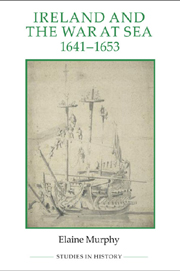Book contents
- Frontmatter
- Contents
- List of figures, maps and tables
- Acknowledgements
- Abbreviations
- Glossary
- Map 1 Ireland, 1641–9: principal ports and locations
- Map 2 The British Isles, 1641–9: principal ports and locations
- Map 3 The British Isles and Europe, 1641–9: principal ports and locations
- Introduction
- PART I The War at Sea, 1651–1653
- 1 The outbreak and spread of the rebellion, October 1641–September 1643
- 2 ‘Weathering the storm’, September 1643–July 1646
- 3 ‘Infested with pirates’, August 1646–August 1649
- 4 The support of the navy, September 1649–April 1653
- Part II Navies and the Conduct of the War at Sea
- Appendices
- Bibliography
- General index
- Index of ships
4 - The support of the navy, September 1649–April 1653
from PART I - The War at Sea, 1651–1653
Published online by Cambridge University Press: 05 April 2013
- Frontmatter
- Contents
- List of figures, maps and tables
- Acknowledgements
- Abbreviations
- Glossary
- Map 1 Ireland, 1641–9: principal ports and locations
- Map 2 The British Isles, 1641–9: principal ports and locations
- Map 3 The British Isles and Europe, 1641–9: principal ports and locations
- Introduction
- PART I The War at Sea, 1651–1653
- 1 The outbreak and spread of the rebellion, October 1641–September 1643
- 2 ‘Weathering the storm’, September 1643–July 1646
- 3 ‘Infested with pirates’, August 1646–August 1649
- 4 The support of the navy, September 1649–April 1653
- Part II Navies and the Conduct of the War at Sea
- Appendices
- Bibliography
- General index
- Index of ships
Summary
The arrival of Oliver Cromwell in Dublin in August 1649 marked the start of a new phase in the war in Ireland. Between 1649 and 1653 the Commonwealth regime faced many demands on its military and naval resources. Regardless of these challenges the conflict in the seas around Ireland remained a priority. The navy was a vital cog in the Cromwellian military campaign which enabled parliamentary armies to go on the offensive against the royalist coalition there. Nicholas Rodgers summed up the importance of the navy in the conquest of Ireland, noting that ‘only the support of the navy allowed Cromwell to campaign in an impoverished country’. Without naval assistance the parliamentary campaigns in Ireland could not have been so sustained or so successful.
September–December 1649
By late summer 1649 news of the preparations for an expeditionary force to be led by Oliver Cromwell was well known in Ireland. In August two Irishmen, captured on a ship sailing from Galway, returned to Wexford and reported seeing 15,000 soldiers and forty-six ships in and around Milford Haven. The question facing the royalist coalition in Ireland was not when would Cromwell sail but where he would land. To limit parliamentary options Ormond advanced his army on Dublin in June and July. Although he succeeded in capturing a number of outlying garrisons including Drogheda and Dundalk, he failed to seize the city and on 2 August 1649 Colonel Michael Jones defeated the royalist army at the Battle of Rathmines.
- Type
- Chapter
- Information
- Ireland and the War at Sea, 1641–1653 , pp. 69 - 86Publisher: Boydell & BrewerPrint publication year: 2012



